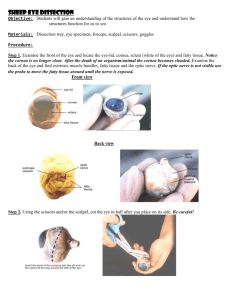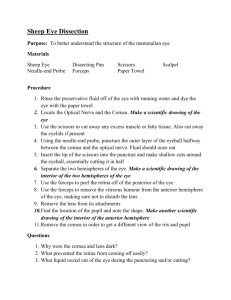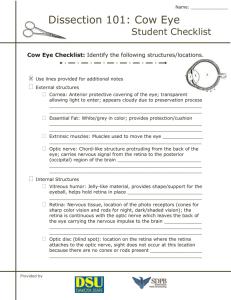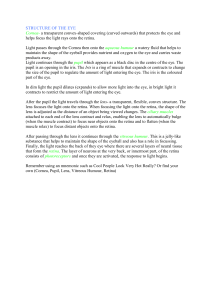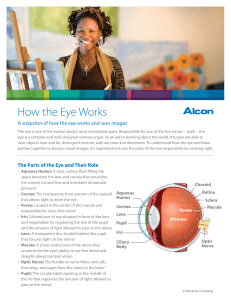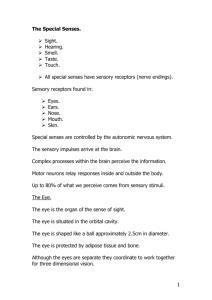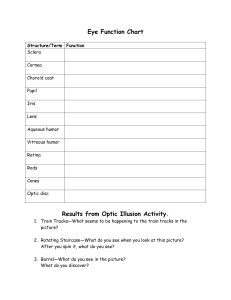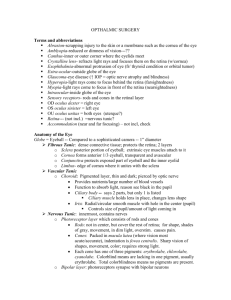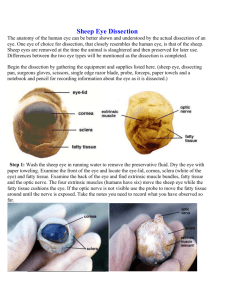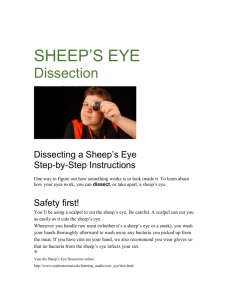Cow Eye Dissection Name: Group Members:
advertisement
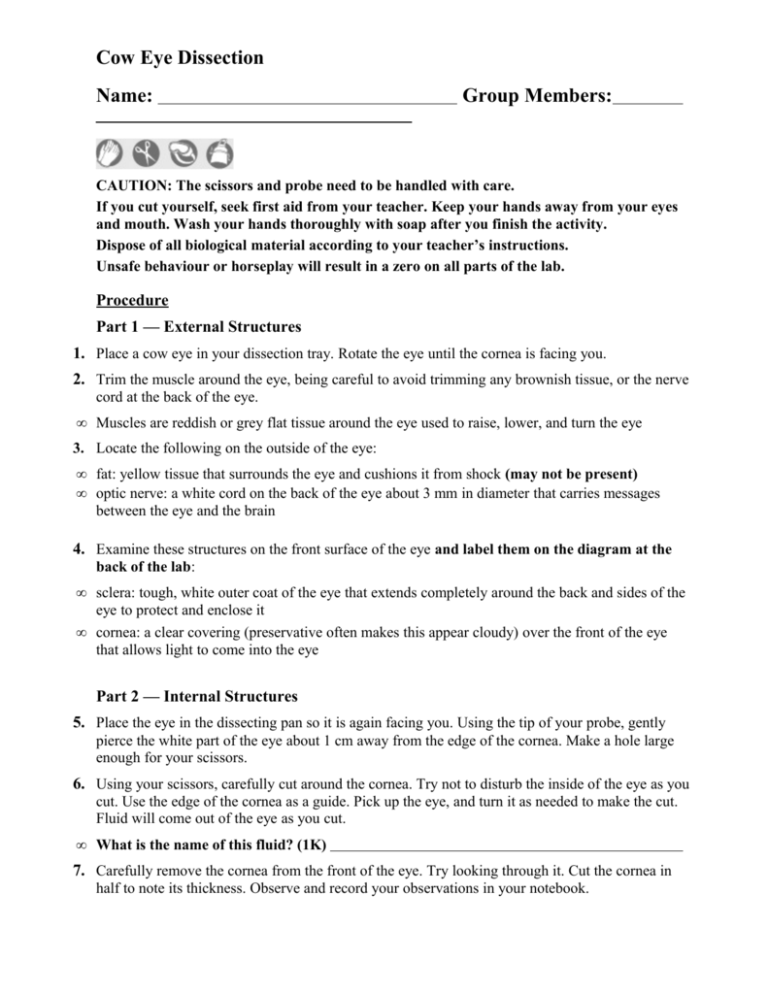
Cow Eye Dissection Name: Group Members: CAUTION: The scissors and probe need to be handled with care. If you cut yourself, seek first aid from your teacher. Keep your hands away from your eyes and mouth. Wash your hands thoroughly with soap after you finish the activity. Dispose of all biological material according to your teacher’s instructions. Unsafe behaviour or horseplay will result in a zero on all parts of the lab. Procedure Part 1 — External Structures 1. Place a cow eye in your dissection tray. Rotate the eye until the cornea is facing you. 2. Trim the muscle around the eye, being careful to avoid trimming any brownish tissue, or the nerve cord at the back of the eye. • Muscles are reddish or grey flat tissue around the eye used to raise, lower, and turn the eye 3. Locate the following on the outside of the eye: • fat: yellow tissue that surrounds the eye and cushions it from shock (may not be present) • optic nerve: a white cord on the back of the eye about 3 mm in diameter that carries messages between the eye and the brain 4. Examine these structures on the front surface of the eye and label them on the diagram at the back of the lab: • sclera: tough, white outer coat of the eye that extends completely around the back and sides of the eye to protect and enclose it • cornea: a clear covering (preservative often makes this appear cloudy) over the front of the eye that allows light to come into the eye Part 2 — Internal Structures 5. Place the eye in the dissecting pan so it is again facing you. Using the tip of your probe, gently pierce the white part of the eye about 1 cm away from the edge of the cornea. Make a hole large enough for your scissors. 6. Using your scissors, carefully cut around the cornea. Try not to disturb the inside of the eye as you cut. Use the edge of the cornea as a guide. Pick up the eye, and turn it as needed to make the cut. Fluid will come out of the eye as you cut. • What is the name of this fluid? (1K) 7. Carefully remove the cornea from the front of the eye. Try looking through it. Cut the cornea in half to note its thickness. Observe and record your observations in your notebook. 8. Observe the lens, the iris, and the ciliary muscle at the front of the eye with the cornea removed. • iris: round black tissue that controls the amount of light that enters the inner part of the eye (may be coloured in humans) • What is the shape of the opening in the iris? How does this compare to the iris in humans? (2 T) • pupil: the round opening in the centre of the eye that allows light to enter and whose size is controlled by the iris • lens: hard, solid structure that can be seen through the pupil (the lens may have fallen into the main cavity of the eye) • ciliary body: black muscle fibres located on the back of the iris that change the shape of the lens 9. Carefully remove the lens and vitreous humour from the eye. Use your blunt probe to help you remove the vitreous humor • vitreous humour: substance found behind the lens that helps to maintain the shape of the eye and supports the inner structures, such as the retina and the lens. 10. Using your scissors, carefully cut the lens in half. Look at the inner surface where you have cut it • Describe the general shape of the lens before cutting it (1C) • Describe what the inside of the lens looks like (1C) • Describe the consistency of the vitreous humor (1C) 11. Cut the back of the eye partly away from the iris and ciliary body to expose the retina and the blind spot. Observe the reflective tapetum at the back of the eye. • retina: tissue in the back of the eye where light is focussed. The surface of the retina is covered with blood vessels that bring oxygen and nutrients to the retina and remove waste. The retina in a living eye is smooth. The retina may be loose, but you can identify it because it will be attached to the back of the eye at the optic nerve • blind spot: nerve cell fibres carrying impulses from the retinal receptors leave the eye in this region and enter the optic nerve. You can locate the blind spot by looking at where the optic nerve exits the eye. • tapetum: reflective tissue found behind the retina in many vertebrates that reflects visible light back through the retina. • Describe the colour and appearance of the tapetum (1C) 12. Dispose of the eye parts in the white tub on the lab tray at front and your gloves in the classroom garbage can. Clean all equipment by rinsing with water in the sink, dry them, and then replace them on the cart at the front of the classroom Analyzing and Interpreting 13. What differences did you notice between a cow eye and a human eye? Specifically mention structures of the eye and how they are different. (2T) 14. Describe how the various parts of the eye function together to make an image appear on the retina. (3K) 15. The eye is a fairly simple structure as compared to a camera, yet it has remarkable abilities. What are some things a human eye can do that a camera cannot do? (2A) 16. Finish labeling all parts of the eye on the diagram below that you have not yet labeled (3K) (fluid) (hole) (fluid) Marks: /7K + /6A* + /4T + /4C = /21 * Includes 4A for performing the lab


